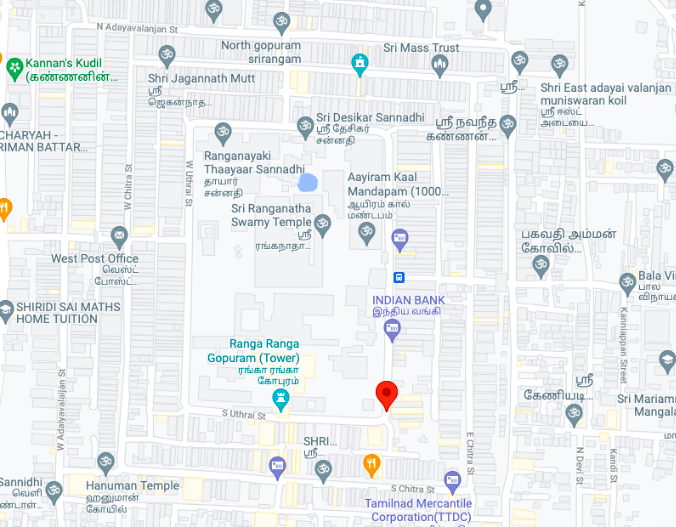One of my favourite things to do–ever–is to browse avidly, with a feverish passion, all the books that occupied every inch of that ground floor of Sri Vaishnava Sri, truly a heaven for Śrīvaiṣṇava products, especially books that they publish and resell. Oftentimes, I end up buying books I already have, but who cares? Actually, going to Śrīraṅgam has more than one perk for me for this reason, and I’m definitely not ashamed to admit that when going to get Śrīvaiṣṇava granthas in Śrīraṅgam, I also make time to visit Raṅganātha.

https://goo.gl/maps/AvE3kMS9sVCnnkAH9 (Couldn’t embed the map for some reason…)
Anyway, to the point now: I found this book, and although I didn’t know what it was about exactly, I did know that Srilata Raman had quoted it in her book when she gives a list of Śrīvaiṣṇava commentaries in Manipravala. Plus, any book by M.A. Venkatakrishnan Swami needs to be acquired. And finally, Vasudevan Swami from the shop said that it was the last copy he had, so that I held it closer to me. I wasn’t going to allow anyone to take it away from me even my accident. One of my wisest decisions.
While going through it many months later, I found that it was a collections of anecdotes, conversations and the like related to the Śrīvaiṣṇava Ācāryas found in the commentaries on the Nālāyira Divyaprabandham. So basically, MAV Swami [EDIT: improving upon PBA Swami’s pioneering work] had painstakingly picked out passages of a hagiographic nature found in the commentaries, explained the context in which they occur and give a clear gloss in modern Tamil. Truly precious possession! His introduction gave me a clear insight into some of the features of these commentaries, and on the commentators themselves. Actually, I should re-read it, taking notes this time.
[UPDATE: Prathik rightly reminded me that it was P.B. Annangaracharya Swami (MAV’s teacher) who first went through the commentaries, picked out such passages and published them in 1953. You can download those books online: Part 1; part 2; part 3; part 4]:

As you probably know, the Śrīvaiṣṇava commentary literature is a veritable ocean, and going through it is likely to prove a Herculean task. It contains not just glosses and explanations, but also hagiographic and theological material, which later became the basis for writing separate hagiographic texts like the Guruparamparāprabhāvam and theological treatises such as Piḷḷai Lokācārya’s Śrīvacanabhūṣaṇam, in Manipravala. Of course, books of these two genres pre-existed the commentaries on the Divyaprabandham, but they were in Sanskrit. So along with checking important info about the Ācāryas in the hagiographic texts, it is also a good idea to go through the commentaries – or, PBA Swami’s or MAV Swami’s books.
Back to the book now: One of the Śrīmukhams is by the 45th Aḻakiyaciṇkar of the Ahobila Maṭham, and he points out that this Śrīvaiṣṇava commentary corpus is the Śaivas’ envy! And how some Śaivas asked U. Vē. Cāmiṉātaiyar to write such a commentary on the Tamil tirumuṟais, to which he replied that the Śrīvaiṣṇava Ācāryas could write such commentaries because they thoroughly mastered Sanskrit and Tamil, which none among them (Śaivas?) did, so such work could not be produced for the tirumuṟais! And this is no exaggeration, truly.
Anyway, I’m in the process of combing through this 700-page book to find interesting examples for some of my papers (and I have quite a few lines up, sigh!), jotting down references. It really is a treasure-trove. Here are some gems that I found in it:

This is such a nice interpretation of the Tiruppāvai line ēr ārnta kaṇṇi yacōtai: Piḷḷai Uṟaṅkā Villi Tācar thinks that Kṛṣṇa’s eyes are beautiful like His mother Yaśodā’s (despite her being an adoptive mother). And MAV Swami points out that Tācar is particularly well-placed to comment upon the beauty of the eyes, as he himself was besotted with his wife’s eyes, and later transferred his admiration to Raṅganātha’s eyes thanks to Rāmānuja’s intervention. This interpretation is recorded in the Āṟāyirappaṭi commentary on Tiruppāvai 1.

OK, we’re already getting Mārkaḻi vibes with all this: an anecdote involving Anantāḻvāṉ, another disciple of Rāmānuja’s, is narrated in the avatārikai of his Nālāyirappaṭi commentary on the Tiruppāvai: he is said to have jumped inside the pond in Śrīvilliputtūr (Āṇṭāḷ’s birthplace) and searched for something. Enquired about it, he said that he was hoping to find at least a piece of turmeric or the like that Āṇṭāḷ or her friends may have left behind after bathing there!

This one is truly beautiful: Parāśara Bhaṭṭar explains that Kṛṣṇa-Dāmodara showed His scar around the waist (from being tied up by Yaśodā) to get us to declare our pledge of loyal devotion to Him (by bearing the conch and discus tāpa, also “scars”, see?)
It’s incredible how much these Ācāryas enjoyed thinking, talking about and explaining the different poems of the Divyaprabandham. They verily breathed and lived the Divyaprabandham. And their enjoyment is both palpable and infectious, and I can’t wait to go back to the book.


One thought on “The lives and words of the Vaiṣṇava Ācāryas”